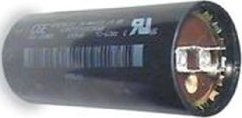Many homeowners have the problem that for what appears to be no reason their house lights will dim for a few seconds. Others may realize that the dimming occurs when a major appliance, that contains a motor, such as an air conditioner, refrigerator or furnace turn on.

Figure 1 - Motor start-up capacitor
Motors require additional power in the form of additional current or amps to turn on. Basically they need this extra power to overcome the inertia of being in a stopped state. In simplistic terms the additional power that they draw can reduce the power available for other electrical devices such as lights. Once the motor is operating or turning at its normal speed it no longer needs the additional energy and the lights will return to their original output.
It is not uncommon to find that a motor requires 50 to 75% more power on start-up then for actual operation. Often within the specifications of the appliance it will state the start-up current (amps) and the run current. Breakers and wires that control the power to the appliance must be capable of handling the start-up power requirements of the device.
It should be noted that the decrease in power to the lights is also affecting all the other electrical devices in the home. The lights are just an obvious visual indication, many electrical devices such as computers will not show that they have low power, but it is not good for the device and can lead to component failure.
In order to offset the additional power that a motor needs in order to start, an electrical component known as a capacitor is installed, as shown in Figure 1. The capacitor stores electrical energy and delivers it to the motor when needed.
However, a capacitor, over time, loses its ability to hold a charge in a similar manner as a rechargeable battery.
This is why a homeowner may start to experience dimming lights when no new electrical appliances have been added to the home’s power loading.
If you start to notice light’s dimming at times, the homeowner should try to determine if other motor driven appliances are starting up simultaneously. If a specific motor driven appliance can be identified service should be performed on that appliance.
The offending appliance does not have to be on the same electrical circuit as the lights.
Note: When asking for service be sure to inform the service technician of the problem that you are experiencing. In many cases a service technician will not check the functionality or replace a part until it has completely died. Which in the case of dimming lights may not be the case, the capacitor might be working, but at less than 100% capacity.
There are other reasons that lights may dim in your home.
- Central air conditioners or refrigerators that are have too much refrigerant, in other words are overcharged, can require additional power during start-up.
- Your local electrical utility has added additional load on the power lines feeding your home and you are facing a brown-out condition. This could be new housing or industrial facilities.
If you cannot identify a specific appliance that is causing the dimming we recommend that you contact your local electrical utility and discuss the situation with them.
